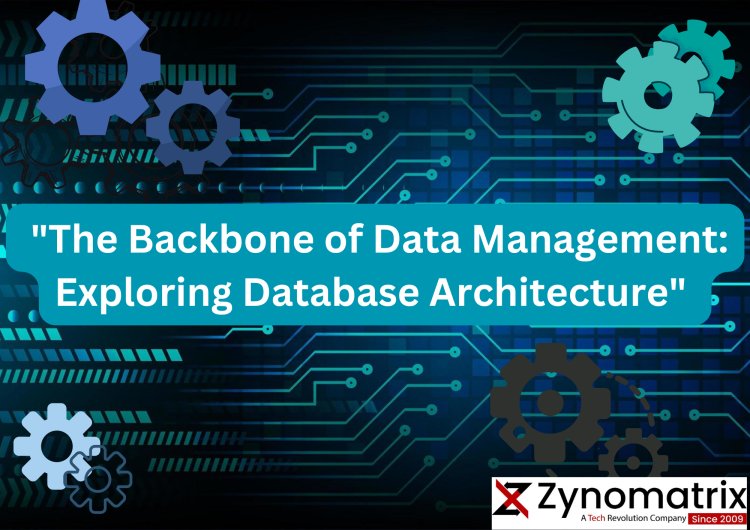"The Backbone of Data Management: Exploring Database Architecture"
The blog post begins by setting the stage with an insightful introduction that highlights the significance of data in modern organizations. It establishes the essential role that database architecture plays in enabling informed decision-making and maintaining a competitive edge. Readers are encouraged to explore the various aspects of database architecture and its impact on effective data management.

Introduction
In the ever-evolving landscape of technology, data has become the lifeblood of organizations. The efficient management, storage, and retrieval of data are crucial for businesses to make informed decisions and gain a competitive edge. At the heart of this data-centric approach lies database architecture – the foundational framework that determines how data is organized, stored, and accessed. In this blog post, we'll delve into the world of database architecture, exploring its types, components, and significance in modern data management.
Understanding Database Architecture
Definition and Purpose: Database architecture refers to the structured framework that defines how data is stored, organized, and accessed within a database management system (DBMS). It lays the foundation for data integrity, security, and efficient retrieval. A well-designed database architecture ensures that data is easily manageable, scalable, and adaptable to changing business needs.
Evolution of Database Systems: Database systems have evolved over the years, moving from hierarchical and network models to the widely adopted relational model. With the advent of big data and the need for more flexible solutions, NoSQL and NewSQL architectures have gained prominence.
Types of Database Architecture
Hierarchical Architecture: This model organizes data in a tree-like structure, where each record has a parent and can have multiple children. It was widely used in early mainframe systems but lacked flexibility for complex relationships.
Network Architecture: Similar to the hierarchical model, the network model allows records to have multiple parent and child relationships. It was an improvement over the hierarchical model but still had limitations in handling complex data structures.
Relational Architecture: The relational model, based on tables with rows and columns, brought a breakthrough in data management. It uses structured query language (SQL) to perform operations on the data and has become the foundation for most modern databases.
NoSQL Architecture: NoSQL databases, which include document, key-value, columnar, and graph databases, offer flexible data models and are suitable for handling unstructured or semi-structured data. They excel in scalability and are commonly used in web applications and big data scenarios.
NewSQL Architecture: NewSQL databases combine the benefits of traditional relational databases with the scalability of NoSQL databases. They aim to provide high performance and horizontal scalability without sacrificing ACID (Atomicity, Consistency, Isolation, Durability) properties.
Key Components of Database Architecture
Data Models: Data models define the structure of the data stored in the database. Common models include hierarchical, network, relational, and document models.
Storage Models: Storage models determine how data is physically stored on storage devices. This includes file-based storage, table-based storage, and more recent advancements like columnar storage.
Query Languages: Query languages, such as SQL for relational databases, allow users to interact with the database to retrieve, manipulate, and analyze data.
Data Integrity Mechanisms: Mechanisms like constraints, triggers, and referential integrity ensure that data remains accurate and consistent throughout its lifecycle.
Factors Influencing Database Architecture Choice
Data Volume and Complexity: The size and complexity of data play a significant role in choosing an appropriate architecture. Relational databases might suffice for structured data, while NoSQL databases are better suited for handling massive amounts of unstructured data.
Performance Requirements: The need for high-speed data retrieval and complex querying can impact architecture choice. Some architectures are optimized for specific types of queries or workloads.
Scalability and Availability: Business growth demands scalable and highly available databases. NoSQL and NewSQL databases are designed to scale horizontally, distributing the workload across multiple nodes.
Consistency and Flexibility: Some applications require strong consistency in data, while others prioritize flexibility. NoSQL databases often provide eventual consistency, while relational databases ensure strong ACID compliance.
Challenges in Database Architecture Design
Balancing Performance and Cost: Choosing the right architecture involves balancing performance requirements with budget constraints. High-performance databases might come with higher licensing and infrastructure costs.
Data Security and Privacy: Protecting sensitive data is crucial. Different architectures have varying levels of security features and encryption capabilities.
Data Migration and Integration: Migrating data between different architectures or integrating databases with disparate architectures can be complex and time-consuming.
Future Trends in Database Architecture
Distributed Databases: Distributed databases leverage clusters of interconnected machines to improve scalability and availability. They are crucial for handling big data and supporting globally distributed applications.
Blockchain and Data Immutability: Blockchain technology's focus on data immutability and decentralized control is finding applications in database systems, especially in industries like supply chain and finance.
Machine Learning Integration: Database architectures are evolving to integrate machine learning capabilities for real-time analytics, predictive modeling, and data-driven decision-making.
What's Your Reaction?





















